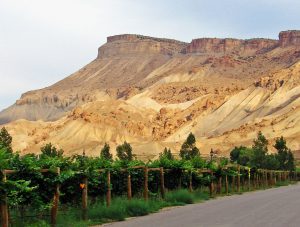The Grand Valley has a reputation as a small, rural area, despite the fact that it’s actually quite urban and populous. As of 2020, Mesa County sports a growing population of 155,703 people, the vast majority of which live in the Grand Valley. With over 10 different communities, it’s the only true metropolitan area in Colorado outside of the Front Range. For this edition of Nifty Names, we wanted to put a spotlight on the major communities of the Grand Valley. We’ll start in the Upper Valley, following the Colorado River downstream to the Lower Valley in the west.
Palisade

Vineyards in Palisade below Mt. Garfield [Creative Commons, photo by Don Graham]
Clifton
Clifton is an unincorporated community in the Upper Valley between Palisade and Grand Junction. Like Palisade, Clifton is named after the Book Cliffs. The “-ton” suffix, which comes from Old English, is closely related to the word “town.” In other words, Clifton literally means “Cliff Town.” Clifton is the second largest community in Mesa County, with a population of 20,413, and is one of the fastest growing areas within the valley. In 2023, the U.S. Department of Agriculture determined that Clifton could no longer be considered rural based on the 2020 census.
Many of Clifton’s largest challenges come from its status as an urbanized unincorporated community. While Clifton does have its own wastewater treatment plant, fire department, and water services, it depends on Mesa County to provide law enforcement, sidewalks, and other municipal services, and on the Colorado Department of Transportation to maintain Highway 6 and the I-70 Business Loop, which bisect the community. Even with these issues, Clifton residents are generally content to remain unincorporated, even as the need for more urban amenities grows larger. Still, with the recent opening of the new Clifton Branch Library and the upcoming Clifton Community Campus, the community is growing fast to meet its challenges.
Grand Junction

Downtown Grand Junction is a blend of historic buildings and modern art. The downtown’s lack of especially tall buildings is intended to provide clear views of the natural scenery. [My photo]
With a population of 65,560, Grand Junction is the largest city between the Denver and Salt Lake City metropolitan areas and is the cultural and transportational heart of Western Colorado. What makes Grand Junction so unique is both its isolation from other major metropolitan areas and its distinct charm as a crossroads between the Mountain West and Southwest. Travel fifty miles in any direction and you’ll find yourself in a variety of environments, from rugged mountains, to scenic deserts, to lush national forests. In a sense, Grand Junction is more than just where the Colorado and Gunnison Rivers converge, it’s a place where different worlds collide into a rich, beautiful tapestry.
Fruita
The City of Fruita, first established in 1894, was named by its founder, William E. Pabor, a poet, agriculturalist, and prohibitionist who did much to promote agriculture in Colorado. I’ve described Pabor’s temperance and agriculturalist views in depth in a Local History Thursday post, and how those views influenced his decision to found Fruita in another Local History Thursday. In the early days, Fruita was best known for its large apple orchards, but also had sizable pear, strawberry, potato, and bean farms. While it doesn’t have the unique microclimate that Palisade has that make it ideal for growing peaches, Fruita at one time dominated the fruit growing industry in the Grand Valley. It was not built to last, however. Starting in 1898, Fruita’s orchards were devastated by a series of cold winters and codling moth infestations. By the 1920s, few orchards were left standing.Today, agriculture continues to play a big role in Fruita’s economy, just with a lot less fruit. These days, Fruita is probably best known for its stellar outdoor recreation, with biking, hiking, fishing, and floating the Colorado River being some of its biggest draws. Fruita is also well known for its paleontology, with the Colorado National Monument and McInnis Canyons National Conservation Area each having many notable fossil sites. Fossils in these locations are protected by federal law, so the best place to learn about Western Slope paleontology is the Dinosaur Journey museum. With a Mesa County library card, you can also check out a Museums of Western Colorado Patron Pass that allows you to visit Dinosaur Journey, Museum of the West, and Cross Orchards for free.
Loma
In the far west of the valley is the small unincorporated town of Loma. Loma is a Spanish word meaning “hill,” which is befitting of the rolling landscape of the Lower Valley. Its primary industry is agriculture, with Loma and neighboring Mack arguably being two of the only communities in the Grand Valley that remain fully committed to their rural, country roots. People there prefer a slower way of life with respect for small-town values and community. While the rest of the valley grows, changes, and diversifies, it’s worth keeping Loma in mind as a place where change happens slowly.
Mack
Mack is named after John M. Mack (often incorrectly printed as John W. Mack), who was the President of the Barber Asphalt Company located in Philadelphia, which in turn owned the Uintah Railroad. The Uintah Railroad was built to carry Gilsonite, a type of solid black organic resin used to produce asphalt, out of Eastern Utah. Mack was founded in 1903-1904 as a terminal connecting the Uintah Railroad and the Denver and Rio Grande Railroad. As far as I can tell, John M. Mack never visited the town, but as President, he got naming rights.
As far as Mack goes today, it’s a small, rural community in the Lower Valley, very similar to Loma, its nearest neighbor. While generally a quiet, sleepy town, Mack attracts thousands of visitors annually during the Country Jam festival every June. The festival averages nearly 100,000 attendees and draws in upwards of $11 million to the valley’s economy each year. With recent headliners including big names like Jason Aldean, Blake Shelton, and Tim McGraw, Country Jam shows that even a rural town like Mack can play a major role within the larger Grand Valley metropolitan area.
____________________________
Growing up in the Grand Valley, I often took for granted how special this area is. I hear a lot of negative sentiments from people about the Valley’s politics, education, and public infrastructure. Everyone’s favorite nickname for Grand Junction is Junktown, after all. For me, I never learned how to really appreciate this area until I learned more about its history, geography, and culture. I feel that learning more about where you live helps to make you feel like you’re part of something bigger than yourself. I hope that you learned something new to appreciate about our slice of Colorado. If you’re from any of these communities, please show some civic pride in the comments and share your favorite part of where you live!
Thank you for reading! You probably noticed that I missed a few communities here, such as Orchard Mesa and Fruitvale. I’ll plan on covering these in a future Nifty Names, so please stay tuned for more.
Thank you to the Friends of Mesa County Libraries for supporting Local History blogs like these.



Enjoyed this!
Thank you!
I enjoy learning about the history of people and places. Reading about the towns in Mesa county was interesting, and I thought well written. My husband is interested on visiting Grand Junction or “Junk Town.” Why Junk Town?
Thank you for sharing! As for as the Junk Town nickname, I think it’s mainly just a bit of self-deprecation. The “junk” part comes from the first syllable of “Junction.” It’s mostly used by locals who are dissatisfied with the city for one reason or another, or from people elsewhere in Colorado who want to get a dig in. It’s a fun nickname, so even people with a good amount of civic pride will use it in a “that’s Junk Town for you” sort of way. Even with everything that makes it special, most people who have grown up here can tell you that it’s a bit of a mess sometimes, but at least it’s our mess. I hope that helps to answer your question!